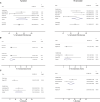Four-factor prothrombin complex concentrate for the treatment of oral factor Xa inhibitor-associated bleeding: a meta-analysis of fixed versus variable dosing
- PMID: 37063756
- PMCID: PMC10099316
- DOI: 10.1016/j.rpth.2023.100107
Four-factor prothrombin complex concentrate for the treatment of oral factor Xa inhibitor-associated bleeding: a meta-analysis of fixed versus variable dosing
Abstract
Background: The optimal dosing strategy of four-factor prothrombin complex concentrate (4F-PCC) to treat oral factor Xa (FXa) inhibitor-associated bleeding has not been established.
Objectives: To evaluate the effectiveness and safety of fixed versus variable 4F-PCC dosing for the management of FXa inhibitor-associated bleeding.
Methods: A systematic literature search and meta-analysis of clinical studies was performed using PubMed, Embase, and Cochrane databases from inception to January 2022. The primary outcomes included hemostatic effectiveness, mortality, and thromboembolic events. Secondary outcomes included 4F-PCC usage, total length of stay in hospital and in intensive care units, and time to 4F-PCC administration. The pooled incidence or mean was calculated using a random-effects model and compared between the 2 dosing strategies.
Results: Twenty-five studies were included and data from 1,760 patients (fixed dosing, n = 228; variable dosing, n = 1,532) were analyzed. There were no significant differences in hemostatic effectiveness, thromboembolic events, or mortality rates between the dosing strategies. Hospital length of stay was significantly longer in the fixed-dosing group, with a mean stay of 7.4 days (95% CI: 3.6-11.1) compared to 5.9 days (95% CI: 5.5-6.3) in the variable-dosing group (P < 0.001). The mean initial 4F-PCC dose was significantly higher with variable dosing than fixed dosing (38 IU/kg; 95% CI: 32-44 vs. 27 IU/kg; 95% CI: 26-28, P < 0.001).
Conclusions: A fixed-dosing strategy appears to be a safe and effective alternative to variable weight-based dosing and was associated with lower 4F-PCC usage. However, direct comparative studies are needed to confirm these results.
Keywords: anticoagulants; anticoagulation reversal; factor Xa inhibitors; hemostasis; prothrombin complex concentrates.
© 2023 The Author(s).
Figures








Similar articles
-
Safety, efficacy, and cost of four-factor prothrombin complex concentrate (4F-PCC) in patients with factor Xa inhibitor-related bleeding: a retrospective study.J Thromb Thrombolysis. 2019 Aug;48(2):250-255. doi: 10.1007/s11239-019-01846-5. J Thromb Thrombolysis. 2019. PMID: 30941571
-
Comparison of Hemostatic Outcomes in Patients Receiving Fixed-Dose vs. Weight-Based 4-Factor Prothrombin Complex Concentrate.J Emerg Med. 2020 Jul;59(1):25-32. doi: 10.1016/j.jemermed.2020.04.049. Epub 2020 Jun 11. J Emerg Med. 2020. PMID: 32536491
-
Utilization of 4-Factor Prothrombin Complex Concentrate for Reversal of Oral Factor Xa Inhibitor-Associated Acute Major Bleeding: A Case Series.J Pharm Pract. 2021 Oct;34(5):755-760. doi: 10.1177/0897190020907012. Epub 2020 Feb 24. J Pharm Pract. 2021. PMID: 32089040
-
Comparison of 4-factor fixed dose versus 4-factor weight-based dose prothrombin complex concentrate for emergent warfarin reversal: a systematic review and meta-analysis.Clin Exp Emerg Med. 2025 Jan 14. doi: 10.15441/ceem.24.265. Online ahead of print. Clin Exp Emerg Med. 2025. PMID: 39807064
-
Effect of low- versus high-dose 4-factor prothrombin complex concentrate in factor Xa inhibitor-associated bleeding: A qualitative systematic review.Am J Health Syst Pharm. 2024 May 24;81(11):e274-e282. doi: 10.1093/ajhp/zxae009. Am J Health Syst Pharm. 2024. PMID: 38430127
Cited by
-
Comparison of Fixed Versus Weight-Based Prothrombin Complex Concentrate Dosing Strategies for Factor Xa Inhibitor Reversal.Clin Appl Thromb Hemost. 2024 Jan-Dec;30:10760296241243368. doi: 10.1177/10760296241243368. Clin Appl Thromb Hemost. 2024. PMID: 38710155 Free PMC article.
-
Effect of PCC on Thrombin Generation among Patients on Factor Xa Inhibitors with Major Bleeding or Needing Urgent Surgery (GAUGE): Design and Rationale.TH Open. 2023 Jul 25;7(3):e229-e240. doi: 10.1055/s-0043-1771300. eCollection 2023 Jul. TH Open. 2023. PMID: 37497426 Free PMC article.
-
2025 Guidelines for direct oral anticoagulants: a practical guidance on the prescription, laboratory testing, peri-operative and bleeding management.Intern Med J. 2025 Jul;55(7):1174-1183. doi: 10.1111/imj.70103. Epub 2025 May 31. Intern Med J. 2025. PMID: 40448969 Free PMC article.
-
European Stroke Organisation (ESO) and European Association of Neurosurgical Societies (EANS) guideline on stroke due to spontaneous intracerebral haemorrhage.Eur Stroke J. 2025 May 22:23969873251340815. doi: 10.1177/23969873251340815. Online ahead of print. Eur Stroke J. 2025. PMID: 40401775 Free PMC article.
-
Co-administration of Four-Factor Prothrombin Complex Concentrate With Andexanet alfa for Reversal of Nontraumatic Intracranial Hemorrhage.Hosp Pharm. 2024 Aug;59(4):394-406. doi: 10.1177/00185787241229192. Epub 2024 Feb 16. Hosp Pharm. 2024. PMID: 38919755 Free PMC article.
References
LinkOut - more resources
Full Text Sources

